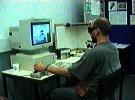Virtual Reality 1993 - 1995
Virtual Reality was most definitely the "next big thing" in the early 1990s. It was high-tech, media-friendly, had counterculture associations and had spawned its own superstar - the bearded and dreadlocked Jaron Lanier. It was also very expensive.
As a recently-graduated researcher at Loughborough University I wanted to get involved in this new field, but had no chance of getting a research grant for it. So I followed the home-brew route. I managed to get hold of a Nintendo PowerGlove via a friend who was visiting the US, then some Sega 3D Shutter Glasses, downloaded the free REND386 software and then built some interfaces using designs I had downloaded from the States. Before long I was up and running with a state-of-the-art DIY VR system.
I decided to start sharing the things I had found out about building this system via the Mac Quadra 900 computer in my office. It was late 1992 (maybe early 1993) and I used the technologies of the day - Gopher and FTP - to allow people to grab documents direct from my computer. The Mac went "ping" every time someone visited my machine and before to long the pinging started to get annoying.
Enter The Web
My new hobby (VR was never part of my paid research job) led to a number of things.
Firstly, it meant that when NCSA Mosaic arrived and made the World Wide Web available to more people (mostly at Universities), I had both the content and interest to make use of it. I turned my VR archive in to a website in 1993 and became one of the earliest websites in the UK. My original server address eta.lut.ac.uk aka 158.125.96.29 can still be found in old logs and server lists in Google.
Secondly, it put me in touch with like-minded people such as Chris Hand and Robin Hollands. The annual BCS HCI conference was happening in Loughborough in 1993 and we decided to meet up there and start a UK Virtual Reality Special Interest Group (UK VR-SIG). I also used my contacts to organise an exhibition of Virtual Reality technology at the conference.
Finally, it gave me a profile as both a World Wide Web and Virtual Reality "expert". I was asked to speak about both topics at events and invited to write for the press. It also brought me to the attention of Colin Angus from The Shamen, and I started to work on the band's website. This lead to other projects and more press interest in my work.
I recall taking my home-brew VR kit down to the new CyberSEED nightclub in London in around 1994 as well as the seminal neo-Psychedelic club Megatripolis and other such events in London. This activity was often part of Martin Kavanagh's "VirtualiTea" room. I recently found an article Cyberculture, Cyborg Post-Modernism and the Sociology of Virtual Reality Technologies by Ralph Schroeder that catches the spirit of the time quite well.
Ironically, I had already started to move my thinking away from Virtual Reality by the time this interest started. I'd been really impressed by Mark Weiser's article The Computer for the 21st Century in Scientific American September 1991 and increasingly realised that the future would be a world augmented by technology not replaced by it. A world created by a computer would never ultimately match up to the world created by nature.
HCI'93 VR Exhibition Website
This is what websites looked like in the mid-1990s:
HCI'93 VR Exhibition Photographs
Written Material
- Virtual Reality - Internet Today Aug 1995 (PDF, 15.5 Mb)
An article about Virtual Reality I wrote for Internet Today magazine.
- Proceedings Of The 1st UK VR SIG Conference 1994 (HTML, 180 Kb)
Presentations given at the First UK VR-SIG Conference in 1994.
- What Is VR (Plain Text, 113 Kb)
State of the art resources from 1993.
- Cyberculture, Cyborg Post-modernism and the Sociology Of Virtual Reality (PDF, 922 Kb)
Surfing the soul in the information age
By Ralph Schroeder
From Futures 1994 26(5) 519-528 - VR Resource Guide From 1994 (Plain Text, 94 Kb)

The Virtual Reality Homebrewer's Handbook
By Robin Hollands with contributions by Sean Clark and Chris Hand. Published in 1996. Still available from Amazon.





















